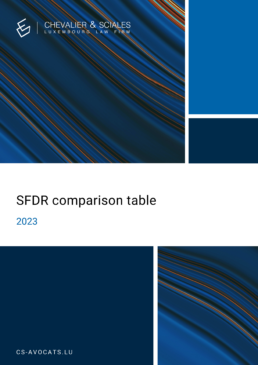Publications
01 September 2023
Compare two products:
| Dark Green Taxonomy aligned products (art.9 SFDR & art.5 Taxonomy Regulation) | Dark Green non-Taxonomy aligned products (art.9 SFDR) | Light Green Taxonomy aligned products (art. 8 SFDR & art.6 Taxonomy Regulation) | Light Green non-Taxonomy aligned products (art.8 SFDR) | Other products (art.6 SFDR & art.7 Taxonomy Regulation) |
|
|---|---|---|---|---|---|
| Characteristics | • Invest in an economic activity that contributes to environmental objectives as set out under the Taxonomy Regulation and social objectives • Do not significantly harm any of the above objectives • The money is invested in companies which follow good governance practices • Comply with the relevant technical screening criteria set out under Taxonomy Delegated Acts | • Invest in an economic activity that contributes to environmental or social objectives (other than those included in the Taxonomy Regulation) • Do not significantly harm any of those objectives. The money is invested in companies which follow good governance practices | • Promote environmental or social characteristics, or a combination thereof, provided that the companies in which investments are made follow good governance practices • Include some sustainable investments with environmental objectives as set out under the Taxonomy Regulation • Do not significantly harm any of those objectives • Align with the relevant technical screening criteria set out under Taxonomy Delegated Acts | Promote environmental or social characteristics, or a combination thereof, provided that the companies in which investments are made follow good governance practises. They may, further, make some sustainable investments non-Taxonomy aligned | Sustainable investments or promotion of environmental and/or social characteristics is not the objective of the product |
| Scope | All investments of the dark green Taxonomy-aligned product must: • contribute at least to one of the six environmental objectives set out in the Taxonomy Regulation (art. 5 Taxonomy Regulation) • comply with the technical screening criteria set out in the Taxonomy Delegated Acts (art. 3 Taxonomy Regulation) • comply with the principle of ‘Do not significant harm’ (art. 3 Taxonomy Regulation) • be aligned with the OECD Guidelines for Multinational Enterprises and the UN Guiding Principles on Business and Human Rights, the eight fundamental conventions in the Declaration of the International Labour Organisation on Fundamental Principles and Rights at Work and the International Bill of Human Rights (art. 3 Taxonomy Regulation) | All investments of the dark green product must contribute to environmental and/or social objectives other than those set out in the Taxonomy Regulation (art. 9 SFDR) and comply with the principle of ‘Do no significant harm’ (art. 2 SFDR) | Light green Taxonomy- aligned products shall promote environmental or social characteristics, or a combination thereof, provided that the companies in which investments are made follow good governance practises (art. 8 SFDR). In addition, the product may make some Taxonomy-aligned sustainable investments with the following characteristics (art. 6 Taxonomy Regulation): • contribute to one of the six environmental objectives set out in the Taxonomy Regulation (art. 3 Taxonomy Regulation) • comply with the technical screening criteria set out in the Taxonomy Delegated Acts (art. 3 Taxonomy Regulation) • comply with the principle of ‘Do not significant harm’ (art. 3 Taxonomy Regulation) • be aligned with the OECD Guidelines for Multinational Enterprises and the UN Guiding Principles on Business and Human Rights, the eight fundamental conventions in the Declaration of the International Labour Organisation on Fundamental Principles and Rights at Work and the International Bill of Human Rights (art. 3 Taxonomy Regulation) | Light green products shall promote environmental or social characteristics, or a combination thereof, provided that the companies in which investments are made follow good governance practises (art. 8 SFDR). In addition, the product may make some non-Taxonomy aligned sustainable investments contributing to environmental and/or social objectives other than those set out in the Taxonomy Regulation | Other financial products should not make sustainable investments or promote environmental and/or social characteristics (art. 6 SFDR). |
| Disclosures at product level | i. Pre-contractual disclosures on the integration of sustainability risks (art.9 SFDR), positive or negative consideration of principal adverse impacts (art.7 SFDR), sustainable investment objectives (art. 9 SFDR and art. 5 Taxonomy Regulation) ii. Template provided in Annex III of RTS iii. Periodic reports (Annex V of RTS) iv. Website disclosures (art. 10 SFDR) All the above disclosures should be reviewed and adapted regularly. | i. Pre-contractual disclosures on the integration of sustainability risks (art. 9 SFDR), positive or negative consideration of principal adverse impacts (art. 7 SFDR), sustainable investment objectives (art. 9 SFDR) ii. Template provided in Annex III of RTS iii. Periodic reports (Annex V of RTS) iv. Website disclosures (art. 10 SFDR) All the above disclosures should be reviewed and adapted regularly. | i. Pre-contractual disclosures on the integration of sustainability risks (art. 8 SFDR), positive or negative consideration of principal adverse impacts (art. 7 SFDR), promotion of environmental and social characteristics (art. 8 SFDR), sustainable Taxonomy aligned investments (art. 6 Taxonomy Regulation) ii. Template provided in Annex II of RTS iii. Periodic reports (Annex IV of RTS) iv. Website disclosures (art. 10 SFDR) All the above disclosures should be reviewed and adapted regularly. | i. Pre-contractual disclosures on the integration of sustainability risks (art. 8 SFDR), positive or negative consideration of principal adverse impacts (art. 7 SFDR), promotion of environmental and social characteristics (art. 8 SFDR), sustainable non-Taxonomy aligned investments (if any) (art. 8 SFDR) ii. Template provided in Annex II of RTS iii. Periodic reports (Annex IV of RTS) iv. Website disclosures (art. 10 SFDR) All the above disclosures should be reviewed and adapted regularly. | i. Pre-contractual disclosures on integration or not of sustainability risks (art. 6 SFDR), consideration or not of principal adverse impacts (art.7 SFDR) and the statement included in art.7 of Taxonomy Regulation The above disclosures should be adapted in case the product wishes to become a light green product (art. 8 SFDR) or a dark green product (art. 9 SFDR). |
| Disclosures at entity level | Website disclosures: • Sustainability risk policy (art. 3 SFDR) • Positive or negative consideration of principal adverse impacts of investments decisions (art.4 SFDR) • Remuneration policy in relation to the integration of sustainability risks (art.5 SFDR) | Website disclosures: • Sustainability risk policy (art. 3 SFDR) • Positive or negative consideration of principal adverse impacts of investments decisions (art.4 SFDR) • Remuneration policy in relation to the integration of sustainability risks (art.5 SFDR) | Website disclosures: • Sustainability risk policy (art. 3 SFDR) • Positive or negative consideration of principal adverse impacts of investments decisions (art.4 SFDR) • Remuneration policy in relation to the integration of sustainability risks (art.5 SFDR) | Website disclosures: • Sustainability risk policy (art. 3 SFDR) • Positive or negative consideration of principal adverse impacts of investments decisions (art.4 SFDR) • Remuneration policy in relation to the integration of sustainability risks (art.5 SFDR) | Website disclosures: • Sustainability risk policy (if it is considered, otherwise a negative statement and the reasons why sustainability risks are not taken into consideration) (art.3 SFDR) • Positive or negative consideration of principal adverse impacts of investments decisions (art.4 SFDR) • Remuneration policy in relation to the integration of sustainability risks (if they are considered, otherwise a negative statement and the reasons why sustainability risks are not taken into consideration) (art.5 SFDR) |
| Benefits and/or Limitations | Benefits: • Increasing investors’ and market interest • increasing domestic market shares in Luxembourg • Reduced rate of subscription tax depending on the proportion of investments in sustainable economic activities Limitations: • High compliance cost • Possible reclassification of product from art. 9 SFDR to art. 8 SFDR in case investments are not exclusively sustainable | Benefits: • Increasing investors’ and market interest • increasing domestic market shares in Luxembourg Limitations: • High compliance cost • Possible reclassification of product from art. 9 SFDR to art. 8 SFDR in case investments are not exclusively sustainable | Benefits: • Increasing investors’ and market interest • increasing domestic market shares in Luxembourg • More flexible than art.9 SFDR products • Reduced rate of subscription tax depending on the proportion of investments in sustainable economic activities Limitations: • High compliance cost | Benefits: • Increasing investors’ and market interest • increasing domestic market shares in Luxembourg • More flexible than art.9 SFDR products Limitations: • High compliance cost | Benefits: • Lower compliance cost Limitations: • Decreasing investors’ and market interest |
Key competencies
arrow_forward Private equity – Fund structuring
arrow_forward Venture capital funds
arrow_forward Real estate – Fund structuring
arrow_forward Hedge funds
arrow_forward Crypto funds
arrow_forward Private debt funds
arrow_forward Infrastructure funds
arrow_forward Sustainable finance and ESG funds
arrow_forward Regulatory and compliance
arrow_forward Restructuring and insolvency
arrow_forward Investment fund litigation
Related news
Related posts:
- CSSF extends submission deadline for SFDR pre-contractual disclosure data collection
- SFDR CSSF FAQ Updates: Fund Names, Sustainable Investments & EPM Techniques
- Taxonomy: EU Commission publishes FAQ to clarify the content of the disclosures delegated regulation under Article 8
- Sustainable Finance – implementation of SFDR level 2 deferred until January 1, 2023




